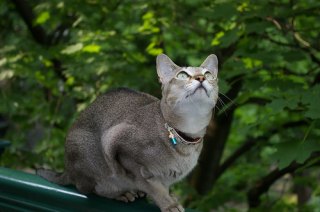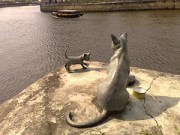
Introduction
This is the smallest of the cat breeds with a ticked tabby coat of sepia and a peaceful, retiring temperament1. They are also described as extrovert, curious and playful2. This breed is rare – there were 2,000 cats worldwide as at 19971.
The retiring temperament and small size is said to originate in the feral cats of Singapore where to survive they had to hide in drains and live nocturnally.
The official story is that the Singapura comes from Singapore. The name “Singapura” (meaning “Lion City”) comes from the name given to Singapore in 1299 by a Sumatran prince.
The image or story fostered by the cat fancy (and the Singapore Tourist Board – SBT) is one of colonies of feral Singapura cats scurrying around the large Singapore drains (the “Drain Cat”) or on the river banks (the “Singapore River Cat”). Perhaps I am exagerating slightly. The picture of the cat, below, was taken in Singaporƒe.

Yet the truth is that the Singapore Cat Club (based in Singapore) could not help breeders from Europe and Japan who wanted to import cats of this breed because there were none in Singapore (unless you count statues – see picture below)3. At least, it appears that that was the case at 2003 or so.
Only about 1 in 1000 of the native Singapore cats resembles this cat breed. The typical feral cat of the area is an understandably nervous bobtailed cat with tabby and tortoisehell coats.

I think that we can rely Dr. Bruce Fogle for the truth as stated in his The Encyclopedia of the Cat (original edition 1997). He probably obtained his information from the Cat Fanciers Association (CFA) website. He states that American cat breeders, Hal and Tommy Meadows brought with them cats from Singapore in 1975 when they returned home from living there.
After seven years selective cat breeding developing the breed, they obtained recognition and in 1988 received championship recognition by the Cat Fanciers’ Association (CFA). That is fast but there was a lot of breeding so the resultant cats would not be necessarily similar the original street cats of Singapore either in appearance or genetically even if the breed originated in the stray cats of Singapore.
Although Dr. Fogle goes on to say that some people believe that the inspiration (only) for creating the Singapura cat came from the feral cats of Singapore and that there are no genetic links between those cats and the cat breed – meaning the breed is an artificial creation.
The Singapore Cat Club, in promoting Singapore, used the Singapora Cat as an emblem at a time when the breed was becoming popular in the West and probably mainly in the USA.

This in no way detracts from the appeal of this delicate and elegant looking, yet robust and muscular cat, the smallest in the cat fancy and just bigger than the miniature and teacup cats that are specially breed very small.
However, when I read about the origins of the Singapura Cat my mind is drawn to thinking of the Sokoke cat, an equally interesting cat with an equally interesting and glamorous (alleged) history. I don’t know, but it just may be that the history of the Sokoke has been ingenously fabricated to boost the appeal of the cat. There may be other examples. Wrong? – please tell me in a comment.

History
| Date | Event |
| 1975 | Singapore cats imported into USA by Mrs and Mrs Meadows. |
| 1982 | CFA recognize this breed |
| 1988 | CFA grant full status (Championship competition). |
| 1991 | Singapore Tourist Board promote this breed as a cat of Singapore. |
| 1997 | Registered with CFA, GCCF and TICA. |
Appearance and Character
Two things stand out, the size and the coat. The Singapura is a little bigger than the size of a miniature cat and weighs 5-6 lbs for females and 6-8 lbs for males, against, for example, the big domestic cats at 13-20+ lbs (Maine Coon) and bigger: the Savannah F1 at about 30 lbs or so.
The second is the Abyssinian-like coat color but in the more subtle shade of light beige or sepia. The color has also been described as “old ivory”. The pattern is the same as the Abyssinian, however. The coat has sepia brown ticking.
The classic eye color is green as you see in the photograph of a wonderful cat named “Emerald” at the top of this page. The color can be yellow and hazel as well.
This cat’s character, as might be expected of a small cat, (with Abyssinian and Burmese genes) is playful, people orientated and intelligent.
 |  |
| Tumbleweed playing and watching © Helmi Flick. These are thumbnails. Please click on them. | |
Breeders and Clubs
Update April 2010: World list of Singapura cat breeders. This is a list of 40 breeders of this cat across the world.
As at 2008…I can find no individual breeder websites in the first 7 pages of a Google search (UK search using Google.co.uk). That possibly means that this cat is not that popular, perhaps not well known or simply rare. The sites I saw beyond page 7, were of breeders breeding more than one cat breed.
I list here, therefore a short selection made by me. If you are a cat breeder and would like to build a website that would top the rankings within 7 months; or, if you would like a dedicated page on this site, contact me, and I’ll tell you how to do it.
The list:
Tres Joli![]() Singapura Cattery
Singapura Cattery
Located in Danville California, USA.
Goldlay![]()
Located in South Buckinghamshire, England. This cattery also breeds Birman, Burmese and Siamese cats.
Singapura Cat Club {link}![]() This is a UK GCCF affiliated breed club.
This is a UK GCCF affiliated breed club.

Notes:

